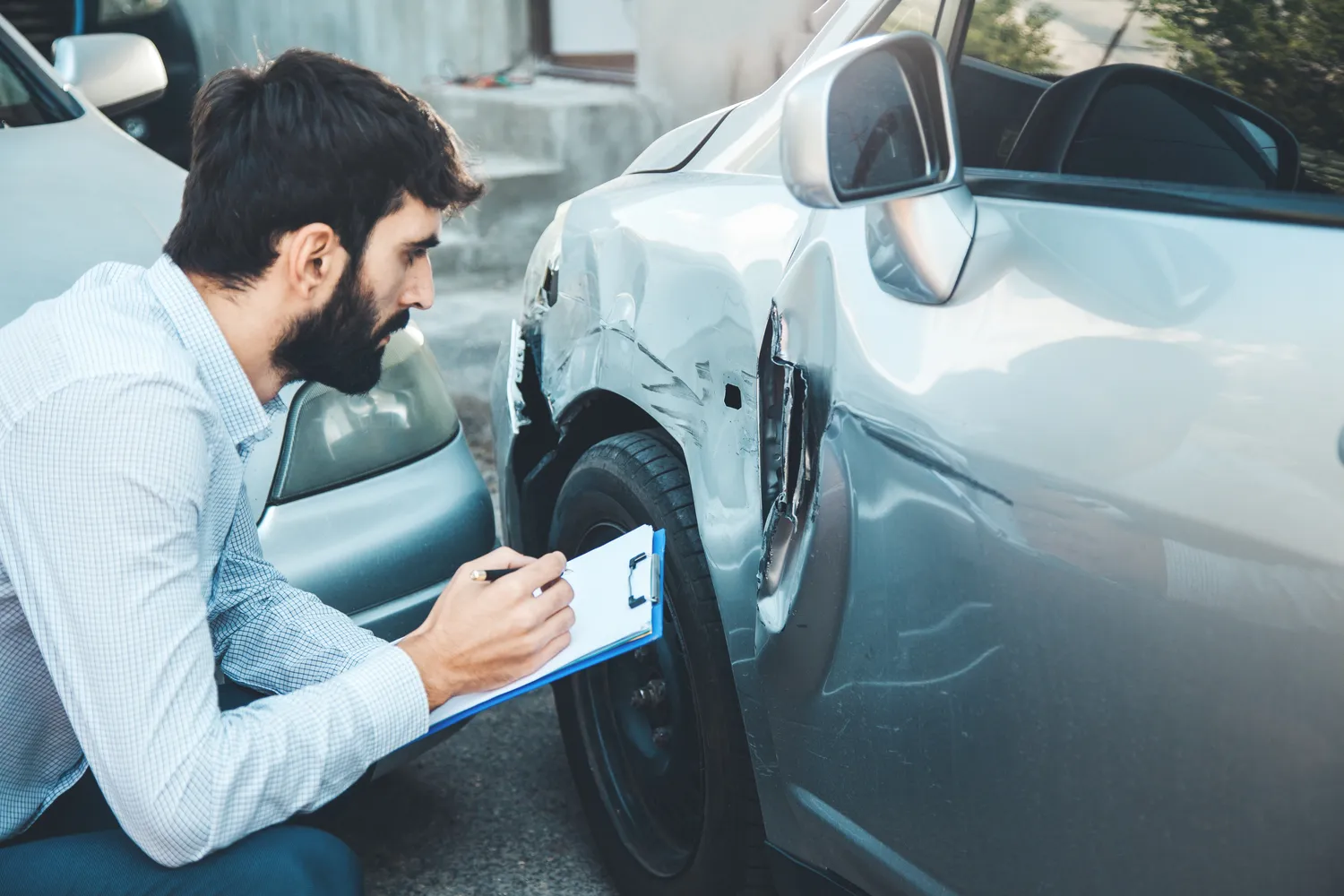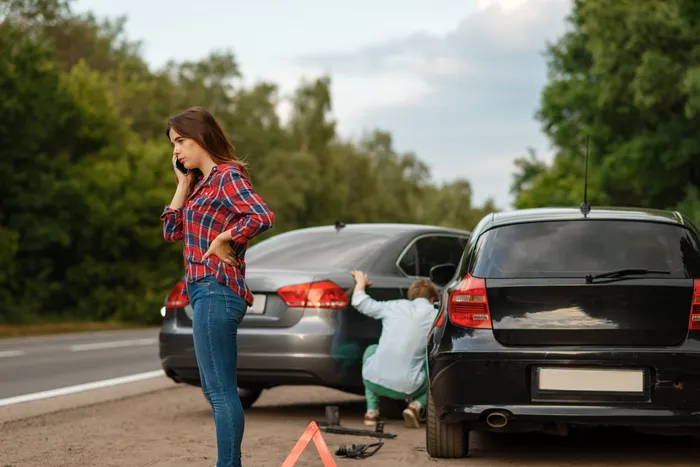7 min read time
Table of Contents

Following a car accident in Nevada, it is crucial that you understand the Nevada law or NRS that surrounds your car accident claim.
Understanding Nevada's car accident laws will give you an advantage when seeking higher settlement amounts.
In this article, you’ll receive crucial information on Nevada’s car accident laws from an experienced Las Vegas car accident lawyer.
Nevada Law on What to Do After an Accident

Nevada car accident laws govern what drivers must do after an accident. This part outlines those accident laws so you can navigate the aftermath of a car accident in Nevada.
1. Stop Immediately and Stay at the Scene
According to NRS 484E.010, if you are involved in a car crash involving death or injury, you must stop your vehicle at the scene or as close to the scene as possible without obstructing traffic more than necessary.
Fleeing the scene can result in felony charges, fines, and imprisonment.
2. Render Aid and Call Emergency Services
Following NRS 484E.030, drivers involved in an auto accident must provide reasonable assistance to anyone injured in the accident. This means:
Call 911 to report the accident and request medical assistance.
Help injured persons get to a safe location if possible.
Arrange for transportation to a medical facility if necessary.
Failure to provide assistance can result in legal penalties and increased liability.
3. Exchange Information
Nevada law requires you to exchange information with the other parties involved in the car accident. According to NRS 484E.030, you must exchange:
Your name, address, and vehicle registration number.
Your driver’s license information upon request.
Also, the same information must be collected from the other parties, including their insurance information.
4. Report the Accident to Law Enforcement
According to NRS 484E.050, if a car accident results in injury, death, or property damage of $750 or more, you must report it to the nearest law enforcement agency.
If an officer is not present at the accident scene, you must file a report with the Nevada Department of Motor Vehicles (DMV) within 10 days.
This report should include details of the accident, the parties involved, and any damages or injuries.
Nevada Car Insurance Requirements

Nevada has insurance coverage requirements to protect drivers, passengers, and property in case of a car accident.
Knowing Nevada’s insurance coverage laws will help you comply with state requirements and be protected in the event of a car crash.
This section will cover the basic car insurance laws in Nevada, coverage requirements, and penalties for non-compliance.
Mandatory Liability
NRS 485.185 requires all drivers to carry a minimum amount of liability insurance.
This insurance will cover damages and injuries you may cause to others in a Nevada car accident where you are at fault. Nevada’s minimum liability insurance requirements are:
$25,000 for bodily injury or death of one person
$50,000 for bodily injury or death of two or more persons
$20,000 for property damage
This is often referred to as 25/50/20 coverage.
More information on Nevada's mandatory insurance coverage can be found on the Nevada DMV's insurance page.
Proof of Insurance
You must carry proof of insurance at all times while driving. NRS 485.187 requires you to provide proof of insurance when:
Requested by LVMPD or Nevada highway patrol during a traffic stop or at the scene of an accident
Registering your vehicle
Renewing your vehicle registration
Acceptable proof of insurance is an insurance card, a digital insurance card on a mobile device, or a printout of your insurance policy.
Penalties for No Insurance
Driving without insurance in Nevada can be very costly. NRS 485.317 states the penalties for not having the required insurance are:
Fines: First-time offenders can be fined $250 to $1,000. Subsequent offenses can be higher.
License Suspension: Your driver’s license can be suspended until you provide proof of insurance and pay the reinstatement fee.
Vehicle Registration Suspension: Your vehicle registration can be suspended, requiring proof of insurance and payment of fees to reinstate.
Additionally, you may be required to file an SR-22 form and a certificate of financial responsibility with the Nevada DMV for three years.
Fault and Liability Laws in Nevada Car Accidents

Understanding Nevada fault and liability laws is key for drivers in motor vehicle accidents.
These laws determine who’s at fault and how the damages get split. Nevada has its own rules and principles for fault and liability, which can impact insurance claims and lawsuits.
We will explain these crucial Nevada car accident laws here so you can understand how fault is determined and what it means for you.
At-Fault State
Nevada is an at-fault state, meaning the driver found to be at fault for the car accident is responsible for the damages.
That includes medical bills, property damage, lost wages, and other related expenses. The at-fault driver’s insurance will cover those expenses up to the policy limits.
How Fault is Determined
Fault in Nevada car accidents is determined by negligence. Negligence is the failure to exercise reasonable care while driving, which causes an auto accident.
Several factors can affect fault:
Traffic Laws: Violating traffic laws (e.g., running a red light, speeding) can be negligence.
Police Reports: The police officers investigating the accident will write an accident report that often includes their determination of fault.
Eyewitness Testimonies: Witness statements can provide insight into what happened.
Evidence: Photos, videos, and physical evidence from the scene can help reconstruct the accident.
Nevada's Modified Comparative Negligence Rule
Nevada follows the modified comparative negligence rule as outlined in NRS 41.141. Under this rule:
Below 50%: If you are less than 50% at fault for the car accident, you can still recover damages. However, your damages will be reduced by the percentage of your fault. For example, if you are 30% at fault and your damages are $10,000, you will receive $7,000.
50% or More: If you are 50% or more at fault, you can’t recover from the other party.
Joint and Several Liability
Nevada uses the doctrine of joint liability and several liability in certain situations with multiple at-fault parties.
This means a plaintiff can recover from any one of the at-fault parties for the full amount of damages regardless of their percentage of fault.
However, this doctrine has limitations and applies only in certain situations, especially in cases of gross negligence or intentional misconduct.
Insurance Claim Process
When you file an insurance claim after an accident in Nevada:
File a Claim with the At-Fault Driver’s Insurance: You should file a claim with the insurance company of the at-fault driver. Their liability insurance should cover your damages up to the policy limits.
Your Own Insurance Company: If the at-fault driver’s insurance is not enough, you may need to file a claim under your uninsured/underinsured motorist coverage if you have it.
Subrogation: Your insurance company may pay for your damages first and then seek reimbursement from the at-fault driver’s insurance through subrogation.
Filing a Claim
Nevada requires you to carry liability insurance, which covers damages if you are at fault in an accident. The process to file a claim is as follows:
Notify Your Insurer: Report the accident to your insurance company as soon as possible. Give them as much info as you can about the accident, including the police report, witness info, and any photos or documentation of the scene.
Claim with At-Fault Driver’s Insurer: If the other driver is at fault, you will need to file a claim with their insurance company. Be prepared to give them evidence of their fault.
Statute of Limitations
Nevada has strict time limits to file car accident claims:
Personal Injury: NRS 11.190 says you have 2 years from the date of the car accident to file a personal injury lawsuit.
Property Damage: For property damage claims the statute of limitations is 3 years from the date of the accident.
Filing a personal injury lawsuit outside these time frames generally means losing the right to obtain compensation.
Types of Damages
In Nevada, car accident victims can recover:
Economic: These are measurable losses like medical bills, lost wages, and property damage.
Non-Economic: These are non-measurable losses like pain and suffering, emotional distress, and loss of enjoyment of life.
Punitive: In cases of gross negligence or intentional misconduct, punitive damages may be awarded to punish the at-fault party and deter future behavior.
Talk to a Nevada Car Accident Attorney Today
If you want to have a Nevada car accident case handled right, contact the experienced car accident lawyers at The Rodney Okano Car Accident Lawyer Law Firm.
With over 20+ years of experience and millions recovered, we have an advanced of Nevada car accident laws, which we use in personal injury claims to obtain our client's maximum compensation consistently.
If you were in a car crash in the Las Vegas area, speak to an attorney today by calling (702) 566-3600 or contacting us via form for a free consultation.
Frequently Asked Questions
Obtain the Compensation You're Entitled To
Contact Us Today
Rodney Okano Car Accident Lawyer is a Las Vegas personal injury law firm with over 20 years of experience helping clients obtain maximum compensation following injuries from accidents such as car crashes, worksite injuries, and slips and falls. Over those years, The Rodney Okano Car Accident Lawyer Law Firm has become an experienced law firm that can ensure exceptional results for any of its clients.





